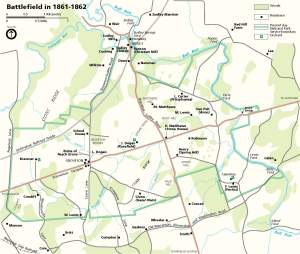Report of Capt. John D. Alexander, Commanding Campbell Rangers
O.R.– SERIES I–VOLUME 2 [S# 2] — CHAPTER IX, pp. 564-565
CAMP NEAR STONE BRIDGE, July, 1861
SIR: In obedience to your orders, on the morning of the 21st instant I reported with my company of cavalry to Major Wheat, who had been thrown forward with his battalion, and occupied a position upon our extreme left in the immediate vicinity of the enemy. By command of Major Wheat, I forthwith proceeded with my whole company to the front for the purpose of reconnoitering, and advanced in close proximity to the enemy’s lines. Having ascertained as precisely as possible his progress and position, I returned and reported the same to Major Wheat. I then by his direction took position a short distance in rear of his left wing, and held my command in reserve, ready to take advantage of any confusion in the enemy’s ranks or to perform any service that might be required. This post I occupied until Major Wheat’s command, with the Fourth South Carolina Regiment, under Colonel Sloan, having gallantly maintained the action for a considerable time, was forced at length to retire before the overwhelming numbers of the enemy and tremendous fire of his batteries. I fell back slowly and without the slightest confusion before the advancing line of the enemy, halting at short intervals and every available point, and holding my company ready for instant service. In this manner I retired, along with Captain Terry’s company, until we fell in with Colonel Radford’s command near Lewis’ house. Major Wheat having fallen from a severe wound received by him early in the action, I joined Colonel Radford’s battalion of cavalry and remained with him the rest of the day.
After the enemy was repulsed and forced back upon our left we received orders with Colonel Radford’s battalion to make a circuit of several miles to our right for the purpose of charging and intercepting the enemy on the turnpike in the direction of Centreville upon their retreat. This order was received by our men with enthusiasm, they having remained the whole day patiently under the enemy’s fire. We came out into the turnpike near the White House, about two miles from the stone bridge. Near this house, and about three hundred yards in rear of the point where we came into the turnpike, the enemy had planted a battery so as to command the road, and in the woods adjacent to the road on either side of the battery they were posted in considerable force. On the opposite side of the road the enemy was retreating rapidly and in great numbers. A portion of the battalion, and among them my company, charged up the turnpike towards the battery, when a tremendous fire was opened upon us from the battery, and also from the whole force stationed in its vicinity. By this fire I lost several horses, but no men. This was the last stand made by the enemy. After they were broken here the rout became general and irresistible. Some of my men joined in the pursuit and became somewhat scattered, but were all collected that night and reported to you the next morning at these headquarters.
I should perhaps mention in appropriate terms the conduct of the officers and men under my command. From the commencement of the action in the morning until late in the evening they were under the enemy’s fire and within point-blank range of their batteries, and at times almost enveloped in their musketry. They remained firm and unshaken, exhibiting an anxiety only to meet the enemy, and awaiting patiently an opportunity to strike an effective blow. I am gratified to inform you that my officers and men all escaped without personal injury. I received a slight wound in my leg, which did not disable me, and in the charge upon the enemy in the evening at the turnpike, which I have mentioned, Lieutenant Page’s horse was shot, and fell dead while in his proper place at the head of the company. During the day we lost four other horses either killed or permanently disabled. I commend the conduct of all my officers and men to your favorable consideration. It gives me pleasure to inform you that my company is now ready to take the field again and to perform effective service.
I have the honor to be, very respectfully, your obedient servant,
JOHN D. ALEXANDER,
Captain of Campbell Rangers
Brig. Gen. N. G. EVANS


Recent Comments